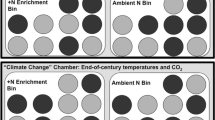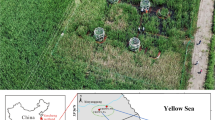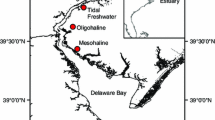Abstract
The replacement of native species by invasive Phragmites australis in coastal wetlands may impact ecosystem processes including fluxes of the greenhouse gases (GHGs) carbon dioxide (CO2) and methane (CH4). To investigate differences in daytime CH4 and CO2 fluxes as well as vegetation properties between Phragmites and native vegetation zones along a salinity gradient, fluxes were measured via cavity ringdown spectroscopy in 3 New England coastal marshes, ranging from oligohaline to polyhaline. While daytime CH4 emissions decreased predictably with increasing soil salinity, those from Phragmites zones were larger (15 to 1254 μmol m−2 h−1) than those from native vegetation (4–484 μmol m−2 h−1) across the salinity gradient. Phragmites zones displayed greater daytime CO2 uptake than native vegetation zones (−7 to −15 μmol m−2 s−1 vs. -2 to 0.9 μmol m−2 s−1) at mesohaline-polyhaline, but not oligohaline, sites. Results suggest that vegetation zone and salinity both impact net emission or uptake of daytime CO2 and CH4 (respectively). Future research is warranted to demonstrate Phragmites-mediated impacts on GHG fluxes, and additional measurements across seasonal and diel cycles will enable a more complete understanding of Phragmites' net impact on marsh radiative forcing.



Similar content being viewed by others
References
Amsberry L, Baker MA, Ewanchuk PJ, Bertness MD (2000) Clonal integration and the expansion of phragmites australis. Ecol Appl 10:1110–1118. doi:10.1890/1051-0761(2000)010[1110:CIATEO]2.0.CO;2
Armstrong J, Armstrong W, Beckett PM, et al (1996) Pathways of aeration and the mechanisms and beneficial effects of humidity- and venturi-induced convections in phragmites australis (Cav.) trin. Ex steud. Aquat Bot 54:177–197. doi:10.1016/0304-3770(96)01044-3
Armstrong J, Jones RE, Armstrong W (2006) Rhizome phyllosphere oxygenation in phragmites and other species in relation to redox potential, convective gas flow, submergence and aeration pathways. New Phytol 172:719–731. doi:10.1111/j.1469-8137.2006.01878.x
Armstrong W (2000) Oxygen distribution in wetland plant roots and permeability barriers to gas-exchange with the rhizosphere: a microelectrode and modelling study with phragmites australis. Ann Bot 86:687–703. doi:10.1006/anbo.2000.1236
Bartlett KB, Bartlett DS, Harriss RC, Sebacher DI (1987) Methane emissions along a salt marsh salinity gradient. Biogeochemistry 4:183–202
Beckett PM, Armstrong W, Armstrong J (2001) A modelling approach to the analysis of pressure-flow in phragmites stands. Aquat Bot 69:269–291. doi:10.1016/S0304-3770(01)00143-7
Bertness MD, Ewanchuk PJ, Silliman BR (2002) Anthropogenic modification of new England salt marsh landscapes. Proc Natl Acad Sci 99:1395–1398. doi:10.1073/pnas.022447299
Brix H (1987) Treatment of wastewater in the rhizosphere of wetland plants-the root-zone method. Wat. Sci. Tech 19:107–118
Brix H, Sorrell BK, Lorenzen B (2001) Are phragmites-dominated wetlands a net source or net sink of greenhouse Gases? Aquat Bot 69:313–324. doi:10.1016/S0304-3770(01)00145-0
Brix H, Sorrell BK, Schierup H-H (1996) Gas fluxes achieved by in situ convective flow in phragmites australis. Aquat Bot 54:151–163. doi:10.1016/0304-3770(96)01042-X
Burdick DM, Buchsbaum R, Holt E (2001) Variation in soil salinity associated with expansion of Phragmites australis in salt marshes. Environ Exp Bot 46:247–261
Chambers RM, Meyerson LA, Saltonstall K (1999) Expansion of phragmites australis into tidal wetlands of north America. Aquat Bot 64:261–273. doi:10.1016/S0304-3770(99)00055-8
Chambers RM, Osgood DT, Bart DJ, Montalto F (2003) Phragmites australis invasion and expansion in tidal wetlands: interactions among salinity, sulfide, and hydrology. Estuaries 26:398–406
Cline JD (1969) Spectrophotometric determination of hydrogen sulfide in natural waters. Limnol Oceanogr 14:454–458
Colmer TD (2003) Long-distance transport of gases in plants: a perspective on internal aeration and radial oxygen loss from roots. Plant Cell and Environ 26:17–36. doi:10.1046/j.1365-3040.2003.00846.x
Ehrenfeld JG (2003) Effects of exotic plant invasions on soil nutrient cycling processes. Ecosystems 6:503–523. doi:10.1007/s10021-002-0151-3
Emery HE, Fulweiler RW (2014) Spartina alterniflora and invasive phragmites australis stands have similar greenhouse gas emissions in a new England marsh. Aquat Bot. doi:10.1016/j.aquabot.2014.01.010
Grosse W, Armstrong J, Armstrong W (1996) A history of pressurised gas-flow studies in plants. Aquat Bot 54:87–100. doi:10.1016/0304-3770(96)01037-6
Hanganu J, Mihail G, Coops H (1999) Responses of ecotypes of Phragmites australis to increased seawater influence: a field study in the Danube delta, Romania. Aquat Bot 64:351–358
Levin LA, Neira C, Grosholz ED (2006) Invasive cordgrass modifies wetland trophic function. Ecology 87:419–432
Lovell CR (2005) Belowground interactions among salt marsh plants and microorganisms. In: Kristensen E, Haese RR, Kostka JE (eds) Coastal and estuarine studies. American Geophysical Union, Washington, D. C., pp 61–83
Madigan MT (2012) Brock biology of microorganisms. Benjamin Cummings, San Francisco
McCormick MK, Kettenring KM, Baron HM, Whigham DF (2009) Extent and reproductive mechanisms of phragmites australis spread in brackish wetlands in Chesapeake bay, Maryland (USA). Wetlands 30:67–74. doi:10.1007/s13157-009-0007-0
Meyerson LA, Saltonstall K, Chambers RM, et al (2009) Phragmites australis in eastern North America: a historical and ecological perspective. Human impacts on salt marshes: A global perspective. University of California Press, Berkeley, CA 57–82.
Middelburg JJ, Klaver G, Nieuwenhuize J, et al (1996) Organic matter mineralization in intertidal sediments along an estuarine gradient. Mar Ecol Prog Ser 132:157–168
Minchinton TE, Simpson JC, Bertness MD (2006) Mechanisms of exclusion of native coastal marsh plants by an invasive grass. J Ecol 94:342–354. doi:10.1111/j.1365-2745.2006.01099.x
Mitsch WJ, Gosselink JG (2000) Wetlands, 3rd edn. Wiley, New York
Moore GE, Burdick DM, Peter CR, Keirstead DR (2012) Belowground biomass of Phragmites australis in coastal marshes. Northeast Nat 19:611–626. doi:10.1656/045.019.0406
Moseman-Valtierra S, Gonzalez R, Kroeger KD, et al (2011) Short-term nitrogen additions can shift a coastal wetland from a sink to a source of N2O. Atmos Environ 45:4390–4397. doi:10.1016/j.atmosenv.2011.05.046
Mozdzer TJ, Megonigal JP (2013) Increased methane emissions by an introduced phragmites australis lineage under global change. Wetlands 33:609–615. doi:10.1007/s13157-013-0417-x
Mozdzer TJ, Zieman JC (2010) Ecophysiological differences between genetic lineages facilitate the invasion of non-native Phragmites australis in north American Atlantic coast wetlands. J Ecol 98:451–458. doi:10.1111/j.1365-2745.2009.01625.x
Poffenbarger HJ, Needelman BA, Megonigal JP (2011) Salinity influence on methane emissions from tidal marshes. Wetlands 31:831–842. doi:10.1007/s13157-011-0197-0
R Core Team (2014) R: a language and environment for statistical computing. R Foundation for Statistical Computing, Vienna, Austria, 2012
Ravit B, Ehrenfeld JG, Haggblom MM (2003) A comparison of sediment microbial communities associated with phragmites australis and Spartina alterniflora in two brackish wetlands of New Jersey. Estuaries 26:465–474
Rooth J, Stevenson JC, Cornwell JC (2003) Increased sediment accretion rates following invasion by phragmites australis: the role of litter. Estuaries 26:475–483
Salter KC, Fawcett RF (1993) The ART test of interaction: a robust and powerful rank test of interaction in factorial models. Commun in Stat-Simul and Comput 22:137–153
Seaman Jr JW, Walls SC, Wise SE, Jaeger RG (1994) Caveat emptor: rank transform methods and interaction. Trends Ecol Evol 9:261–263
Silliman BR, Bertness MD (2004) Shoreline development drives invasion of phragmites australis and the loss of plant diversity on new England salt marshes. Conserv Biol 18:1424–1434. doi:10.1111/j.1523-1739.2004.00112.x
Tokida T, Miyazaki T, Mizoguchi M, Seki K (2005) In situ accumulation of methane bubbles in a natural wetland soil. Eur J Soil Sci 56:389–396. doi:10.1111/j.1365-2389.2004.00674.x
Tong C, Wang W-Q, Huang J-F, et al (2012) Invasive alien plants increase CH4 emissions from a subtropical tidal estuarine wetland. Biogeochemistry 111:677–693. doi:10.1007/s10533-012-9712-5
Valiela I, Cole ML (2002) Comparative evidence that salt marshes and mangroves may protect seagrass meadows from land-derived nitrogen loads. Ecosystems 5:92–102. doi:10.1007/s10021-001-0058-4
Wigand C, McKinney RA, Charpentier MA, et al (2003) Relationships of nitrogen loadings, residential development, and physical characteristics with plant structure in new England salt marshes. Estuaries 26:1494–1504. doi:10.1007/BF02803658
Windham L (1999) Microscale spatial distribution of phragmites australis (common reed) invasion into spartina patens (salt hay)-dominated communities in brackish tidal marsh. Biol Invasions 1:137–148
Windham L (2001) Comparison of biomass production and decomposition between phragmites australis (common reed) and spartina patens (salt hay grass) in brackish tidal marshes of New Jersey, USA. Wetlands 21:179–188
Windham L, Ehrenfeld JG (2003) Net impact of a plant invasion on nitrogen-cycling processes within a brackish tidal marsh. Ecol Appl 13:883–896
Windham L, Lathrop RG (1999) Effects of phragmites australis (common reed) invasion on aboveground biomass and soil properties in brackish tidal marsh of the Mullica river, New Jersey. Estuaries 22:927. doi:10.2307/1353072
Wobbrock JO, Findlater L, Gergle D, Higgins JJ (2011) The aligned rank transform for nonparametric factorial analyses using only anova procedures. Proceedings of the SIGCHI Conference on Human Factors in Computing Systems. ACM, pp 143–146
Acknowledgments
This work was supported by the USDA National Institute of Food and Agriculture (Hatch project # 229286, grant to Moseman-Valtierra) and the National Science Foundation EPSCoR Coperative Agreement (#EPS-1004057, fellowship to Martin). Waquoit Bay National Estuarine Research Reserve provided access to our Sage Lot Pond site. C. Wigand provided valuable feedback on this manuscript, and we sincerely thank her for her helpful comments. We thank I. Armitstead, L. Brannon, I. China, S. Doman, S. Kelley, T. Moebus, A. Moen, and R. Quinn for field support, and C. Martin for assistance with development of R code for expediting data analysis. We are grateful to three anonymous reviewers for their helpful comments, which greatly improved the quality of this manuscript.
Author information
Authors and Affiliations
Corresponding author
Rights and permissions
About this article
Cite this article
Martin, R.M., Moseman-Valtierra, S. Greenhouse Gas Fluxes Vary Between Phragmites Australis and Native Vegetation Zones in Coastal Wetlands Along a Salinity Gradient. Wetlands 35, 1021–1031 (2015). https://doi.org/10.1007/s13157-015-0690-y
Received:
Accepted:
Published:
Issue Date:
DOI: https://doi.org/10.1007/s13157-015-0690-y




